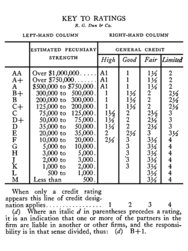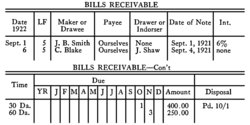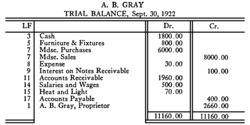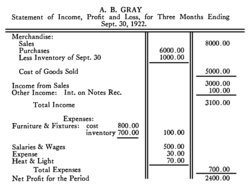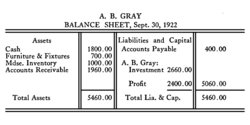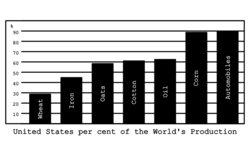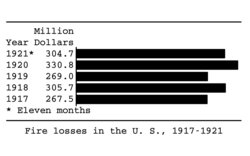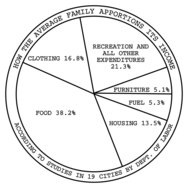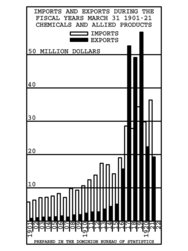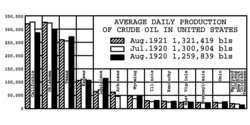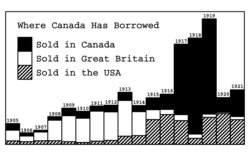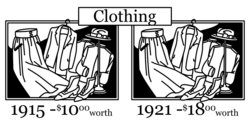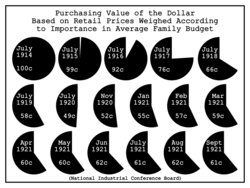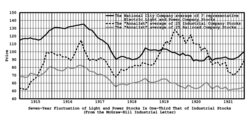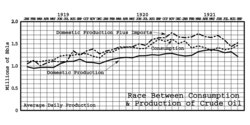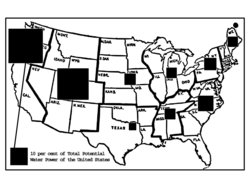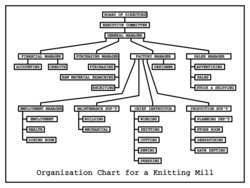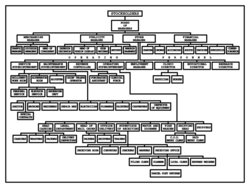Section XXXI: The Business Library
The secretary must be a student of business. He should make it a rule to add to his own personal library at least one business book a month, to be read and studied and digested. In some of the larger offices such a library is provided for the use of employees. In nearly every public library will be found a section devoted to business books. At least it will be possible to find in the catalogue or bibliography a number of books that will be of value. Discrimination should be exercised in reading books, whether they will be of value to you, and whether the writer is an authority. An author's connections, which are usually stated on the title page, should establish his right to be trusted to present nothing that is not to be accepted as authentic. Many business books, however, will be merely one man's opinion. These generally deal with questions of theory. In order to make sure of your ground on any problems of this kind, it is well to read several authors, ascertain wherein they agree, and use your judgment on the points where they do not.
It should be remembered, however, that a book in the library or on your desk is not a guarantee that you know what is in it. To be of value it should be studied. The principles laid down should be applied in your everyday work, if they apply directly to the matters you are handling. The secretary should discuss with his employer any questions that arise in his reading, and get his opinion on them. This will be useful in two ways. It will enable you to get the view of a practical business man, and it will also show him that you have the interest of the business at heart by further preparing yourself to assume responsibility.
As has been suggested in another section, the secretary should as soon as possible decide upon the course he will pursue and then read everything that will assist him in reaching the goal he has set for himself. By all means read the business magazines, the trade journals, and the special articles that appear in the general magazines. If you are connected with the stock and bond business, for example, you should make it a point to study financial news, the personnel of recognized companies, their directorates, the annual reports of companies, and so on. If you are in a bank, you will naturally study everything you can lay your hands on relating to banking.
From “Business Education,” the publication of New York University, we take the following chart which, as stating deep-rooted truths, is potent with possibilities:
| Reading for | Facts should be | Accurate |
| | | Important |
| | | Relevant |
| | Understanding of principles should be | Broad |
| | | Deep |
| | Inspiration should be | Dynamic |
| | | Frequent |
Apply these principles to all your reading and you will be surprised at how much more you get out of it whether it is done for profit or purely for pleasure.
Specific Application of Reading - The business library can be made the source of continuous growth in power of accomplishment by the secretary. One of the factors that retards the promotion of the secretary and reduces his efficiency, more than anything else perhaps, is ignorance of business practices, and the underlying principles of the whole structure. Much of this knowledge naturally must be acquired by experience. Nevertheless, there are standard works on nearly every conceivable phase of business today that may be read and studied with profit by the secretary. Many of these books are fundamental to all lines of business; others are technical and apply to a particular field. The student of secretarial work can lay the foundation for specialized study by becoming familiar with the phases of business practice and principles that apply to business in general. General principles only will be considered here. It would be unprofitable to start out on any program of study of technical lines of business until the secretary has decided, or has been compelled to decide by force of circumstances, which line he expects to engage in.
Economics - Economics is fundamental to all business. It is “The social science that deals with human needs and the satisfaction of those needs.” The study of economics gives us roughly a conception of the whole field of business in its larger aspects - human needs, wealth, utility, industries, consumption, production, economic modifications, labor, capital, the state, exchange, money, instruments of exchange, monopoly, markets, currency system of the United States, banking, distribution, wages, competition, profits, the application of the economic theory to the relations of the individual to society, and so on. It is not expected that the student become an economic specialist from such study. If he grasps a few of the fundamentals and has these as a center around which to build a more ambitious structure, our object will have been accomplished. An introduction to the study, such as is given in Laing's “Introduction to Economics,” may form the starting point. The list of books given at the end of this section will prove of interest to the student who has read Laing's text.
Business Organization - A study of business organization enables us to understand the business machine and how it functions. Without this understanding it is impossible for the secretary, who it is expected has ambitions to go on up in the business world, to learn where he is going and how to get there. This subject, however, is discussed in a special chapter of this book.
Office Management - The secretary will at first come in more direct contact with this feature of business than any other, except those which relate to his technical duties. Several phases of this subject may be studied with advantage. First, the organization of the office for the more effective work; second, a study of its mechanical equipment; third, a study of the arrangement of the office; forth, a study of the factors relating to the personal side - personnel.
Salesmanship and Advertising - The secretary will find a study of these subjects of value. The subjoined list of business books contains the titles of a number which may be read with profit.
Other Business Books - The secretary who expects to advance in his profession must be a constant student. He must follow an effective program of reading. Generally the course of reading should follow some such program as follows:
-
Books relating to the broad underlying principles of business, economics, etc.
-
Books relating to the secretary's own particular field.
-
Books that deal with the line of business or industry or profession in which one is engaged.
List of Business Books
| | GENERAL |
| |
| Title | Author | Publishers |
| Business a Profession | L. D. Brandeis | Small, Maynard & Company, Boston |
| Economics of Business | N. A. Brisco | The Macmillan Company, New York |
| The Empire of Business | Andrew Carnegie | Doubleday, Page & Company, New York |
| The Corporate Organization | T. Conyngton | The Ronald Press Company, New York |
| The Economics of Enterprise | H. T. Davenport | The Macmillan Company, New York |
| An Introduction to Economics | Graham A. Laing | The Gregg Publishing Company, New York |
| Monopolies and Trusts | R. T. Ely | The Macmillan Company, New York |
| Business Administration | E. D. Jones | The Engineering Magazine Company, New York |
| The Modern Trust Company | F. B. Kirkbridge & J. E. Street | The Macmillan Company New York |
| The Human Side of Business | F. Pierce | The John C. Winston Company, Philadelphia |
| Thoughts on Business | W. P. Warren | Forbes & Company, Chicago |
| Business Organization and Administration | J. Anton de Haas | The Gregg Publishing Company, New York |
| |
| | TECHNICAL |
| |
| How to Persuade and Convince | B. C. Bean | The Business Men's Publishing Company, Detroit |
| Marketing Methods | R. S. Butler | Alexander Hamilton Institute, New York |
| The Science and Art of Salesmanship | S. R. Hoover | The Macmillan Company, New York |
| Salesmanship and Salesmanagement | J. G. Jones | Alexander Hamilton Institute, New York |
| Men Who Sell Things | W. H. Moody | A. C. McClurg & Company, Chicago |
| Economics of Retailing | P. H. Nystrom | The Ronald Press Company, New York |
| How Department Stores Are Carried On | W. B. Phillips | Dodd, Mead & Company, New York |
| Merchandizing | J. B. Swinney | Alexander Hamilton Institute, New York |
| Advertising and Its Mental Laws | H. F. Adams | The Macmillan Company, New York |
| Advertising, Selling, and Correspondence | Galloway & Harmon | Alexander Hamilton Institute, New York |
| Writing an Advertisement | S. R. Hall | Houghton, Mifflin Company, Boston |
| The Clock That Has No Hands, and Nineteen Other Essays about Advertising | H. Kaufman | George H. Doran Company, New York |
| Advertising Writing, Theoretical and Practical | E. T. Page | The Page Davis Company, New York |
| The Principles of Advertising Arrangement | F. A. Parsons | Prang Company, New York |
| First Principles of Advertising | W. D. Nesbit | The Gregg Publishing Company, New York |
| The Psychology of Advertising | W. D. Scott | Small, Maynard & Company, Boston |
| Advertising: Its Principles and Practices | Tipper, Hollingsworth, Hotchkiss and Parsons | The Ronald Press Company, New York |
| Retail Buying | C. C. Field | Harper & Brothers, New York |
| Effective Business Letters | E. H. Gardner | The Ronald Press Company, New York |
| Secretarial Work and Practice | A. Nixon and G. H. Richardson | Longmans, Green & Company, New York |
| The Science and Practice of Management | A. H. Church | The Engineering Magazine Company, New York |
| The Twelve Principles of Efficiency | H. Emerson | The Engineering Magazine Company, New York |
| Motion Study | F. B. Gilbreth | D. Van Nostrand Bros., New York |
| Installing Efficiency Methods | C. E. Knoeppel | The Engineering Magazine Company, New York |
| Business Finance | W. H. Lough | The Ronald Press Company, New York |
| Approach to Business Problems | A. W. Shaw | Harvard University Press, Cambridge, Mass. |
| Principles of Scientific Management | F. W. Taylor | Harper & Brothers, New York |
| Engineering Office Systems and Methods | J. P. Davies | McGraw, Hill Publishing Company, New York |
| The American Office | J. W. Schultz | The Ronald Press Company, New York |
| Office Management | A. W. Shaw | The A. W. Shaw Company, Chicago |
| Increasing Human Efficiency in Business | W. D. Scott | The Macmillan Company, New York |
| Individuality | E. L. Thorndyke | Houghton Mifflin Company, New York |
| Psychology | Wm. James | Henry Holt & Company, New York |
| Psychology in Daily Life | C. E. Seashore | D. Appleton & Company, New York |
| Commercial Law | C. D. Gano | American Book Company, New York |
| Essentials of Commercial Law | W. H. Whigam | The Gregg Publishing Company, New York |
| World's Commercial Products | W. G. Freeman | Ginn & Company, New York |
| Corporation Finance | W. H. Lough | Alexander Hamilton Institute, New York |
Current Events - In order to know what is going on at the present time one must know where to look for reading on timely events. There are only two sources from which the secretary, or any other delver in books, may find such information - the newspapers and the magazines. But even to scan either of these sources every day would be a laborious task. There are several sources of guidance in current reading which are at the disposal of the secretary:
| The New York Times Index. |
| The New York Times Current History Magazine. |
| Public Affairs Information Service (Wilson & Company). |
| Information, published by Bowker and Company. |
| The various year books found in nearly all libraries. |
| Almanacs. |
| Indexes to Magazines. |
| Street's Pandex of the News. |
| The London Times Index. |
Most of these books are to be found in every library or in the editorial rooms of newspapers. Some of them at least every secretary will have access to for reference.
By addressing the Superintendent of Documents, Washington, D. C., a list of books and pamphlets published by the government will be sent. Some of these are for free distribution; others may be purchased at a small outlay.
Secretarial Problems: Review and Research Questions
-
What advantages can you see in the suggestion that the secretary make it a practice to read business books?
-
How would you get the benefit of knowledge you acquired from a business book?
-
Have you read any books on economics? If so, state what you conceive the subject to be.
-
How will a knowledge of business organization be of value to you?
-
Have you given any thought to the lines of promotion open to a secretary? If so, state what these are, or what you conceive them to be.
-
Have you read any of the business books listed? Make a report on what benefit any one of them has been.
-
What three general classifications of books will the secretary find it valuable to study?
Secretarial Problems: Laboratory Assignments
-
The manager wishes a list, similar to the one given in the foregoing, of all books you may find in the public library relating to business subjects. If the branch in which you are employed is located in one of the large cities, you may reduce the list to one hundred titles.
-
He will assign one of these to be read during the month and a report to be made on it.
-
Dictation.
-
Transcription.
Section XXVII: Sources of Information and Data for Addresses and Speeches
The collection of data to be used as a basis for the preparation of speeches or addresses is often an interesting and educative phase of the secretary's work. It is the general practice among men who have speeches to prepare to make an outline of the subjects to be discussed. In a majority of cases the data for the outline will be furnished from their own knowledge. It may be necessary to supplement this outline with some definite research work to clear up doubtful points or to enrich the discourse with quotations from different specialists in the subject, or to expand its content and scope. The purpose of the address, what it is to contain, its length, method of treatment, and so on, should be predetermined so that an unnecessary collection of material will be avoided.
Outline - The speaker himself must prepare an outline for his speech. At first this will generally be extended. Marginal notes should be made of phases of the subject to be looked up in reference books, magazines, or elsewhere. Suggestions for expansion or contraction, or of the points where the emphasis should lie, should be noted.
Sources - The section on reference books deals exhaustively with sources of information. This should be consulted before starting the research work, so that the standard sources of information may be kept in mind. It can also be determined in this preliminary survey what books are to be consulted. The librarians of any good library will be found to be invaluable aids in the search for material. They will be able to make definite suggestions for sources of information, and should be consulted freely.
Collection of Material - It will be necessary perhaps to read much and to make notes here and there of statements of facts, statistics, quotations, etc. The judgment of the searcher will be constantly brought into play as to what is important and what is not. It will require considerable summarizing ability and a keen sense of values. It will be well, however, to make notes very full. It must be remembered that all this material is to be transformed into the speaker's own words. Consequently ideas, arguments in support of ideas or theories, are more important than the language.
Need for Accuracy - Where figures, statistics or direct quotations are used, the secretary must observe the strictest accuracy. Whatever license a speaker takes as to the poetic nature of his language or of his eloquence, flights of fancy and the like, his facts are to to be right. The secretary must be depended upon to furnish nothing but supportable data.
Stories - Nearly every speaker attempts to make his speech more human by the introduction of stories and jokes. It is a popular and effective expedient in revitalizing waning attention, or in enforcing a point. The wise secretary will make a selection of these from various sources and classify them for future use. A story should be used to illustrate a point. It should therefore be to the point. In the collection of material of this nature, studiously avoid the commonplace.
Systematic Collection of Material - Some speakers constantly keep in mind future addresses. Many of these will be on the same topic. The secretary should therefore collect from time to time material that may be of value, classifying it and having it ready when the need arises. The availability of such material is greatly increased by providing folders for different topics, upon which may be noted references.
Typing - Notes written for the use of a speaker should be written with wide spacing, to leave room for addition or emendation. It is important to organize the material so that the story flows along smoothly in logical order. Whether or not the notes are brief or full will depend largely upon the speaker. The speaker who carefully prepares his addresses will not need anything but a bare outline. Others do not require anything at all. They do all the preliminary work so thoroughly that the speech flows along without a pause.
Secretarial Problems: Review and Research Questions
-
Make a brief outline of the steps to be followed in securing data for speeches and addresses.
-
What is meant by an “outline” and of what does it consist?
-
What are the principal sources of information?
-
Outline briefly the method you would pursue in collecting material.
-
How are notes for a speaker prepared?
Secretarial Problems: Laboratory Assignments
-
The manager is asked to speak on the subject, “Business English.” Make an outline of the subject to cover about thirty minutes, approximately 3500 words. State the sources of your information.
-
The manager is to speak at the State University on the subject, “Training Secretaries for Effective Work.” Make an outline from which he can give his address. The address is not to exceed thirty minutes in duration.
-
The manager is to make a ten-minute after-dinner speech at a business club luncheon on the subject, “Responsibility of Employer to Employee.” He is not an easy speaker but desires to make a good impression, because of his interest in the subject. Prepare an outline. If possible, illustrate some points with a story.
-
Dictation.
-
Transcription.
Section XXXIII: Office Reference Books
“Knowledge is of two kinds. We know a subject ourselves, or we know where we can find information upon it.” - Boswell
Every secretary who hopes to be his employer's second sense must know how to find information on any subject that may be required. Use of a public or large private library must of necessity be the resort of the secretary in such an emergency. His first defence against failure to deliver the information asked for, is to know how to obtain access to the required books. Some large businesses will provide reference-books which will give, in most instances, the information that the secretary may be called upon to find; but more often the secretary will find that the office in which he is employed is lacking in such reference-book equipment. What then is he to do? He has only one recourse - the library. But to know how to use a library most effectively and most economically of time is one important phase of secretarial training. It consists in acquiring what university professors call “book-using skill.” From the library the secretary should be able to gain all the information that the library affords on any subject asked for by his employer. To get this information he must know the method of arranging reference books in the library. To learn how to use the “tools” provided is not a burdensome task. Every library employs one or more persons whose duties are to aid users of the library in finding the information desired. From these individuals the secretary in a very short time can learn how to use the card catalogues, the arrangement and classification of reference books, and, in libraries which issue permits to the book stalls, the method of shelving.
There constantly arise, in every business office, questions that can be settled definitely only by reference to authorities or specialists in the different subjects. These problems are sometimes concerned with purely technical questions, but more often are in connection with questions of English, spelling, punctuation, arrangement of forms, facts of history, quotations from literature, etc. In addition to the need for authoritative books on such subjects, there is still another class of information that must also be available to the secretary - directories of various kinds, business reference books, etc. In every well-organized business there is to be found a more or less complete library of books of reference. But having reference books available is one thing, and knowing how to use them to get information quickly and reliably, is another.
Dictionary - The dictionary is perhaps the book that is most consulted by the stenographer or secretary. To make the best use of the dictionary, its organization and purpose should be studied. The most economical way of using it advantageously should be determined. The secretary who is really interested in the question of the English language will find much profit in reading and studying the introductory part of Webster's New International, particularly the “Preface,” “A Brief History of the English language,” “Guide to Pronunciation,” “Orthography.” The list of abbreviations is for reference only.
It will be noted that certain guide words are given at the top of the columns. In the first column, the first word on the page is given and the second is the last word on the page. These key words facilitate quick reference. In Webster's New International, words are grouped in two classes. The frequently recurring words are printed on the upper part of the page and the less frequent words at the bottom. If the word desired cannot be found in the primary list the secondary list should be consulted. In order to get the exact pronunciation of a word, it is necessary to be familiar with the diacritical marks employed. At the bottom of each page there is given a list of key words (common everyday words with which we are familiar) in order to assist in understanding the correct sounds.
In studying the definitions of words the parts of speech should be considered with them. In studying words be sure that your interpretation is correct. Usually this can be determined by the use made of the word in the illustrative sentences. The syllabic division of words should also always be noted.
It is important for the secretary to remember that not all dictionary words are words of current use. Slang, archaic and colloquial words and expressions are so indicated in the dictionary, and, naturally, are not to be used. The dictionary should be consulted concerning any new word or word whose meaning is not perfectly clear. The proper study of the dictionary will add tremendously to your power of expression and understanding of written and spoken language. “Outlines in Dictionary Study” by Anna L. Rice, will be of great value in studying the dictionary systematically.
The secretarial student should have on his desk an abridged dictionary for reference at all times.
English - The secretary is dealing with the English language every hour of his business day, and he is supposed to know his language. Nevertheless several books for study and reference should be available when needed. The following books are recommended for reference:
-
Grammar
-
English Grammar Simplified, Fernald - Funk & Wagnalls
-
Reed & Kellogg's Grammar - Merrill
-
Applied Business English - The Gregg Publishing Company
-
Rhetoric
-
Foundations of Rhetoric, Adams Sherman Hill, American Book Company
-
Composition
-
Sentence and Theme Work, Scott Foresman & Company
-
Composition and Rhetoric
-
Effective Expression, The Gregg Publishing Company
Punctuation - Most books on English contain chapters on punctuation and these may be consulted freely when troublesome points arise. “Applied Business Correspondence and Punctuation,” published by The Gregg Publishing Company, is a useful book to have for reference.
A more comprehensive text is Klein's, “Why We Punctuate.”
Roget's Thesaurus - The secretarial student will gain a correct idea of the value of this admirable book from an introductory statement in it:
“The present work is intended to supply, with respect to the English language, desideratum hitherto not supplied in any language; namely, a collection of the words it contains and all the idiomatic combinations peculiar to it, arranged not in alphabetical order as they are in the dictionary, but according to the ideas which they express.”
The assistance the Thesaurus gives is that of furnishing on every topic a store of words and phrases adapted to express all of the recognized shades and modifications of the general idea under which those words and phrases are arranged. It helps us to select out of the whole mass of expressions relating to any subject, the exact expression we wish to use to give a clear idea of our conception. The student will find it of distinct value to read the entire introduction and study its organization as he would the organization of a dictionary. Briefly the book may be used:
-
To find a word to express a given idea.
-
To find appropriate words or new ideas on any given subject.
Synonyms and antonyms are given also. The tabular synopsis of categories should be studied.
Style Book - The style book deals with many of the troublesome details of writing, mostly mechanical points that are constantly cropping up in connection with a secretary's work. It is intended as a guide for writers in preparing their manuscript for printers, but it is equally valuable to the secretary or stenographer in preparing his letters or whatever he writes. It discusses, for example, rules for composition, capitalization, italics, quotations, spelling, punctuation, division, indexing, type, technical terms, hints to authors and editors, proofreaders, copyholders, specimens of type faces, etc. Perhaps the most authoritative book is “A Manual of Style” published by the University of Chicago Press, Chicago, Illinois.
Synonyms and Antonyms - The Thesaurus discusses these words but not as exhaustively as such a book as “Crabb's Synonyms.” Crabb's is an invaluable addition to any secretary's office-reference equipment.
Secretarial Problems: Review and Research Questions
-
What reference books are of the greatest use to the secretary?
-
What cautions are to be observed with regard to words found in the dictionary?
-
What is a “thesaurus”? How does it differ from a dictionary?
-
What is a “style book”?
-
What information does “Who's Who” contain?
-
Of what value is a study of synonyms and antonyms?
Secretarial Problems: Laboratory Assignments
-
A discussion has arisen in the office as to how many uses the word “to” can be put. Consult the dictionary and make a full report on this word. You are not to copy the section from the dictionary but summarize and illustrate the whole.
-
The manager is very much averse to the use of slang, at least during business hours. He has asked each member of the staff to make a complete list of all the slang words they know or use and to set opposite these equivalent expressions in good English.
-
Dictation.
-
Transcription.
Office Reference Books, part II
The following are purely informational and need not be consulted unless needed in given cases.
City Directory - The city directory is supposed to contain the name, business and home address of all the citizens of a city or town. The names are arranged alphabetically.
Telephone Directory - The telephone directory gives all the information usually given in the city directory and in addition the telephone numbers. It contains only the names, addresses and telephone numbers of subscribers. It does not necessarily contain all the names of persons residing in apartment houses and is therefore somewhat limited in its use except for the main purpose of giving the telephone number of subscribers. How to use the telephone directory has already been discussed under “The Technique of Telephoning.”
Suburban Telephone Directories - In all large cities a special directory for suburban subscribers is available. Frequently the names of suburban residents is also found in the regular telephone book.
When names cannot be found in the city telephone directory, the suburban directory should be consulted.
Classified Business Directory - Classified business directories are available in most large cities, but as practically all businesses nowadays avail themselves of the utility of the telephone the classified telephone directory serves a similar purpose. In a classified business directory the names are classified according to business, as, for example, banks, groceries, lawyers, doctors, dentists, butchers, and so on.
Who's Who in America - This book contains the biographies of distinguished men and women in America. It is a selected list and is supposed to contain only the names of those whose accomplishments in the different fields of human activity have been worth while. It is particularly useful in furnishing information about men and women of affairs, or in giving data for selected mailing lists.
Bullinger's Post Office, Express, and Freight Guide - The guide contains the names of every post office, railroad station, boat landing, and United States port, with the railroad or water route on which each place or the nearest communicating point is located, and the shipping directions by express or freight line from New York City.
For any place not located directly on a railroad it gives the nearest railroad station. It designates which post offices are money order offices, and the location of county seats.
R. D. means rural delivery. Mail matter for those places should bear the name of the post office from which the rural delivery is made and the number of the route. The names to which a star is prefixed are money-order post offices.
The names in capital letters are state capitals.
The names followed by c.h. are county seats.
Law Library - Nearly all lawyers have available a library of books concerning their profession. The secretary in a lawyer's office should familiarize himself with this so that when books are needed for making abstracts or for reference they can be readily found. He should also know the location of the larger law libraries, which are available in all cities of any size.
Business Books - Practically every business has its own literature. There may be found in all public libraries books relating to various lines of industry. The secretary will find it to be a valuable accomplishment to be familiar with the standard works relating to the business he is engaged in. In another chapter there will be found a list of business books that are of value to the secretary and to the student of business in its larger aspects. The Department of Commerce, Washington, is constantly issuing books relating to different industries. It would be well to secure a catalogue of these which may be obtained from the Superintendent of Documents, Washington, D. C. Many of these books and pamphlets are for free distribution; others may be purchased at a small outlay. A list of books which you think may be useful to your employer should be made up and kept for ready reference. The government also issues a weekly magazine called “Commerce Reports,” which is a weekly survey of foreign trade, published by the Bureau of Foreign and Domestic Commerce, which is invaluable to the business man.
Congressional Directory - The Congressional Directory, containing the names of the members of Congress and their addresses, both at home and in Washington, the personnel of various committees, etc., is useful to the business man who is interested in governmental affairs.
Mercantile Agencies - The mercantile agencies - the most important of which are Dun and Bradstreet - issue books giving the credit rating of business men throughout the United States. The secretary may be called upon to collect information from these books and should, therefore, be familiar with the process.
The lists in the reference books are arranged according to states and cities. Hence, if the financial rating of Mr. W. M. Phillip, of Buffalo, New York, is desired the secretary should look first under “New York” and then find the city, “Buffalo.” There will be found arranged alphabetically the names of the different business concerns. After each name a figure and a letter are given, thus, “AAA1.” These figures refer to a schedule of classified credit ratings in another part of the book, by referring to which the credit rating may be easily obtained. See Figure LXXI. Two ratings are given, the capital rating and the credit rating. The capital rating indicates the approximate amount of capital invested in the business. The credit rating is the judgment of the agency as to the financial confidence that can be placed in the corporation or individual firm. In other words, it is an estimate of the corporation, firm or individual ability to discharge its obligations, based on quite accurate information collected by the agency through an organized system of securing reliable information.
Causes of Failure - Lack of training in the fundamentals which underlie all business makes men incompetent; leaves them ignorant of the experience of others; rates them as poor risk for capital; blinds them to the ordinary safeguards of credit extension; and exposes them to all the frauds which prey on business ignorance. Consequently the following reasons why men fail, as reported by Bradstreet, are all factors to be considered in judging of a man's ability to carry out his undertakings:
| Cause | % |
| Incompetence | 38.2 |
| Inexperience | 5.6 |
| Lack of Capital | 30.3 |
| Unwise Credits | 1.3 |
| Fraud | 7.0 |
| Failures of others | 1.7 |
| Extravagance | 1.1 |
| Neglect | 1.7 |
| Competition | 1.1 |
| Specific conditions | 11.3 |
| Speculation | .7 |
| | 100.0% |
World Almanac - One of the most useful reference books the secretary can have available is the World Almanac, issued by the New York World annually. The price is 50¢. The Almanac is in fact an encyclopedia of information and statistics about nearly every conceivable industry and activity of modern times. Moreover, it is up-to-date.
Secretarial Problems: Review and Research Questions
-
Outline the most effective way of using the telephone directory.
-
Of what use is such a book as Bullinger's Post Office, Express, and Freight Guide?
-
What are mercantile agencies? Name the two most important ones.
-
What information do the mercantile agencies' reports contain?
-
What is the most frequent source of failure in business?
-
What lesson can you draw from this?
Secretarial Problems: Laboratory Assignments
-
The manager will give you the names of six persons whose telephone numbers and home addresses he wishes recorded on cards.
-
The manager requests information on the financial standing of the following concerns. Upon consulting Dun's reports you find the key numbers as indicated. Make a list of the firms and show what the key numbers, giving the pecuniary and general credit ratings, indicate. All the data may be obtained from the key to ratings.
| | | | Pecuniary Strength | General Credit |
| | | William Crawford Company, Minneapolis Minnesota | C | 1½ |
| | | Andrews Motor Corporation, Detroit, Michigan | A | A1 |
| | | Falcon Paper Mills, Fitchburg, Massachusetts | D | 2½ |
-
The manager wishes a memorandum containing the following information. This may be obtained from the World Almanac:
-
The name and address of the senior senator from Idaho.
-
The total amount of anthracite coal produced in the United States in 1921.
-
The average price of cotton in 1920, compared with the average price in 1915.
-
The farm wage averages for 1920, compared with those of 1915.
-
Dictation.
-
Transcription.
Section XXXIV: Secretarial Bookkeeping
It is assumed that the student of secretarial work is somewhat familiar with bookkeeping and the discussion of the subject that follows is intended more as a review than as an attempt to present the subject exhaustively. Ordinarily the secretary will not be called upon to perform the work of a bookkeeper. That is a technical field, requiring the services of those especially trained for it. Nevertheless, there are certain duties that the secretary will perform in connection with the keeping of personal financial records of the employer that will be greatly simplified if the secretary possess a knowledge of the subject. Many executives make it a practice to turn over to their private secretaries all matters relating to income and expenditures - incomes from salary, investments, and the like. These matters they prefer to keep separate from any organization bookkeeping. Usually such records are very elementary and in their actual operation do not require an extensive knowledge, but the more comprehensive the student's knowledge is the better able he will be to understand principles and to apply them in his business experience.
General Definitions - Bookkeeping is the systematic recording of changes in values, as they occur in business.
An account is a summary of transactions grouped under a single heading; thus, a cash account contains all the items relating to cash, that is, receipts and payments of money.
The left-hand side of the account is the debit; the right-hand side is the credit.
An asset is anything of value owned by the business.
A liability is a debt owed by the business.
Capital is the excess of assets over liabilities. If the liabilities exceed the assets, the excess is called a deficit.
An inventory is a list of the quantities on hand, usually expressed in money figures. Inventories are usually figured at cost price.
There are two systems of bookkeeping: the double-entry and the single-entry.
The double-entry system records the effect on all the accounts involved in any change of values. As the double-entry system gives the only complete record, it is the prevailing and most satisfactory one. The single-entry system records the effect of a transaction upon one of the accounts involved, usually an account with a person. The remainder of this chapter relates to double-entry bookkeeping.
Rules of Debit and Credit
When cash is received, the amount of that asset is increased, and therefore the cash account is debited. When cash is paid, the amount of the asset is decreased, and the cash account is credited.
When a note is given by the business, it increases the liability known as notes payable, and that account is credited. Later when the note is paid, the liability is decreased and the account, notes payable, is debited.
When there is a withdrawal of capital or a loss, it decreases the capital and the capital account should be debited. When a profit or a further investment of capital is made, it increases capital, and the capital account should be credited.
Secretarial Problems: Review and Research Questions
-
What is “bookkeeping”? Why is it necessary in business?
-
Define “account,” “inventory.”
-
What is an “asset”? A “liability”? “Capital”?
-
Explain the meaning of “double-entry.”
-
Give the rules of “debit” and “credit” as applied to assets, liabilities, and capital.
Secretarial Problems: Laboratory Assignments
-
Classify the following items as to assets, liabilities, or capital:
-
Cash on hand, $100
-
Investment by the proprietor of $1000
-
A debt owed John Brown, $300
-
Office furniture on hand, $600
-
A note given by us to James Free, $500
-
Calculate the following inventory of merchandise and arrange it in tabular form:
Mdse. on hand: 228 bu. potatoes; 345 bu. wheat; 147 bu. oats; 220 bu. rye; 150 bu. corn.
Cost prices: Oats 40¢; potatoes $1.25; rye 74¢; corn 56¢; wheat $1.12.
-
Give the entries for the following transactions. Explain why each item is debited or credited.
-
Sell merchandise $200 to Harold Marshall, on account.
-
Purchase a safe for the office for $300, paying $100 cash, and giving our note at 60 days for the remainder.
-
The proprietor invests $2000 cash in the business.
-
Draw a draft on Harold Marshall for $200 in favor of ourselves.
-
Dictation.
-
Transcription.
Secretarial Bookkeeping, part II
Books of Entry - A transaction is recorded usually in two places: first, in the order of its happening, in what is called a “book of original entry”; second, in a “book of final entry” where it is grouped in an account with others of its kind. The books of original entry commonly used are: journal, cash book, sales book, purchases book, note or bill book. The book of final entry is the ledger, which is the book of accounts.
Transferring items from a book of original entry to the ledger is called “posting.”
The journal, or day book, as it is sometimes called, is probably the oldest book of original entry. The other books are offspring, as shown by the fact that all entries placed in them may be placed in the journal, although perhaps with a great deal more labor. A double-entry journal appears as follows:
The figures at the left of the entries indicate the pages of the ledger on which the respective accounts are found. The column in which these figures appear is called the ledger folio column.
The credit items are written about one-half inch to the right of the debit items. The first entry is read, “John B. Doe (debtor) to notes payable, $100.00.” Successive dates are placed above the center of each entry. The journal is now used chiefly for entries which cannot be made in the special books.
The cash book, sometimes called cash journal, contains all items relating to cash. It is arranged to cover two pages, the left-hand page containing debit cash items and the right-hand page the credit cash items. It is virtually a cash account. The form is as follows:
As cash is debited on the debit side, the accounts appearing there (John Lane, notes rec.) are credited. The item concerning John Lane is read, “cash (debtor) to John Lane, $100.00.”
The balance of the cash book is found by subtracting the total of the credit side from the total of the debit side. This balance is placed on the credit side in red ink, indicating that it is only temporarily there, and is then transferred to the debit side in black ink, below the double ruling.
The sales book records sales of merchandise to customers. Merchandise consists of the articles bought for the purpose of sale. The customers' accounts collectively are known as accounts receivable. The following is a form of sales book:
Sometimes, as in the illustration, the total of a bill is placed on the same line with the name of the customer. The first entry here is read, “John Lane (debtor) to sales, $204.00.”
Frequently sales books are made in loose-leaf, carbon-copy, and other forms.
The purchases book records all purchases of merchandise from creditors. The creditors' accounts, collectively, are known as accounts payable.
The purchases book indicates the value of a special book. In this case, we should credit the three creditors for the amount of the liabilities respectively, but debit purchases only once, with the total of the page. If there were 100 entries instead of three, it would be evident that we should post 100 credits and 1 debit, or 101 items instead of 200 as would be the case if each were entered in the journal and posted individually. The saving here would be 99 postings.
The bills receivable and bills payable books are usually combined in one volume. The ruling is the same for both; so the illustration given below of the bills receivable book will give a very good idea also of the bills payable book.
Both notes and accepted drafts are entered in these books. They are sometimes used as books of original entry, and sometimes only as auxiliary records, an entry being made in the journal for the note.
In addition to the books described, other special books may be brought into use as the needs of the business warrant. There may be a petty cash book, sales rebates book, etc., depending upon the need of the particular system. Much use is made of the columnar journal, or special-column book, which may be adapted to a wide variety of needs.
The ledger is the book to which the items from all books of original entry are posted. In this process of transferring, care must be taken to include the following information: amount, date of the transaction, explanation, and page of the book from which it came (J-2, C-5, etc.) When the ledger page is recorded in the folio column of the book of original entry, the transaction is automatically cross-indexed. A ledger account appears thus:
Recording a transaction - A record of any transaction, to the bookkeeper, usually arises from the receipt of some paper, although it may come from oral instructions. In the latter case, the bookkeeper probably makes some memorandum in writing. The following steps are then taken:
-
Preparation of the necessary forms.
-
The original entry.
-
Final or ledger entry.
-
Disposal of papers.
Thus, in a sale,
-
an order sheet and a bill are prepared;
-
the entry is made in the sales book;
-
posted to the ledger; and
-
the order sheet filed and the bill sent to the customer.
Secretarial Problems: Review and Research Questions
-
Name and tell the purpose of the books of original entry.
-
What book may serve the purpose of all the books of original entry? Why?
-
What is a ledger? Explain how entries are recorded in it.
-
Show how a purchases book or a sales book is a labor saving device.
-
Give in order the steps in recording a business transaction.
Secretarial Problems: Laboratory Assignments
-
Assume that you are employed as Secretary to our manager, and that he asks you to keep a set of books for his private finances. The set will consist of a cash book, a journal, and a ledger.
Make entries for the following transactions:
January 2. The manager's cash balance is $3260, deposited in the Cotton Exchange Bank. He also owns 20 shares of the stock of the Richfield Oil Company, which cost him $2000. Record these facts on the books.
January 4. Fred Somer, a friend of the manager, borrows $200 from him, giving his note at 10 days, without interest.
January 9. Pay the Prudential Insurance Company $340 premium on the manager's life policy No. 3478921.
January 13. Received a dividend check for $160 from the Richfield Oil Company.
January 14. Fred Somer pays $200 by check, in settlement of his note due today.
January 15. The manager receives his salary check amounting to $500. Deposit this check, together with those received from the Richfield Oil Company and Somers.
January 20. The manager purchases a Dodge Bros. business coupé for $1025 from the Star Garage Company, Agents, giving his check for $525, and a note payable in 30 days, with interest at 6%, for the remainder. Prepare the check and the note for signature.
January 22. The manager desires $150 for personal expenses. Draw a check to the order of “Cash” and charge it to “Sundry Expenses.”
-
Post these entries to the ledger.
-
Dictation.
-
Transcription.
Secretarial Bookkeeping, part III
The Trial Balance - The trial balance is a list of the accounts of the ledger, with their footings or balances. Its purpose is to ascertain whether equal debit and credit entries have been made in the ledger for every transaction, that is, whether the ledger is in balance.
There are two forms of trial balance: the trial balance by totals, and the trial balance by differences. In the former, the totals of both sides of each account are entered in the trial balance. In the trial balance by differences, only the difference or balance of the account is entered. A debit balance goes to the debit column, and a credit balance to the credit column. The following form illustrates the trial balance by differences, which is the more common form:
To Find Errors in a Trial Balance
-
Add both columns again, carefully.
-
Check the items on the trial balance against the ledger accounts.
-
Find the difference between the two sides. If divisible by 2, this may indicate the posting of an item to the wrong side. If divisible by 9 the error is probably one of transposition or incorrect placement of figures; as, $272 for $227, or $15 for 15¢.
-
Go over the addition and subtraction of figures in the accounts of the ledger.
-
Check the books of original entry with the ledger.
Statement of Income, Profit and Loss - This statement shows the result of the operation of the business for any period of time selected. The following is a simple form:
(The ledger figures are the same as those used in the preceding trial balance.)
All profits are grouped together, and all expenses likewise. If the profits exceed the expenses, the difference is the net profit; if vice versa, the result is the net loss.
Balance Sheet - The balance sheet, like the trial balance, is a statement of the condition of the business on a certain day, while the statement of income, profit and loss covers the operations of a certain period of time. The balance sheet is a statement of the assets, liabilities, and capital of the business. Any net profit is added to the capital. Assets = Liabilities + Capital; or, Capital = Assets - Liabilities.
Secretarial Problems: Review and Research Questions
-
Explain the preparation of a trial balance.
-
What are the steps in finding errors in a trial balance?
-
What is the purpose in taking a statement of income, profit and loss?
-
What is a balance sheet? How does it differ from the statement of income, profit and loss?
-
Explain how the capital section of the balance sheet proves the correctness of the statement of income, profit and loss.
Secretarial Problems: Laboratory Assignments
-
Take a trial balance from your ledger of the last set of problems.
-
Prepare a balance sheet showing the assets, liabilities and net ownership of the manager.
-
From the trial balance and statements of A. B. Gray given in this section, prepare a working sheet (sometimes called a six-column balance sheet).
-
Dictation.
-
Transcription.
Secretarial Bookkeeping, part IV
Closing the Ledger - It is desirable, after having found the conditions shown by the statements, to record these facts on the books. This is called “closing the ledger.”
The inventories should first be entered in the journal, using the following form (for example, Furniture & Fixtures):
| Furniture & Fixtures (New) | 700.00 |
| Furniture & Fixtures (Old) | 700.00 |
The Furniture & Fixtures accounts, after posting these items, will appear as follows:
All asset accounts showing inventories should be treated similarly.
The next step is to dispose of the profits and losses remaining in the various accounts. Profits are found on the credit side, and losses on the debit side. The example, “Furniture & Fixtures, Old,” as given above, shows $100 loss. This is transferred to the profit and loss account by the following journal entry:
| Profit & Loss | 100.00 |
| Furniture & Fixtures (Old) | 100.00 |
When posted, this closes out the Furniture & Fixtures, Old account and the asset is shown by the New account. All accounts showing losses should be treated similarly.
The entry to transfer profits is illustrated by that for interest on notes receivable:
| Int. on Notes Receivable | 100.00 |
| Profit & Loss | 100.00 |
This closes the account, Interest on Notes Receivable. After doing the same with Mdse. Sales, our Profit & Loss account appears:
The balance of $2400, the net profit, is entered in the journal:
| Profit & Loss | 2400.00 |
| A. B. Gray, Prop. | 2400.00 |
and the profit and loss account is closed by posting the debit member of this entry. When the credit member is posted, the proprietor is credited with the net profit for the period, which increases his capital to that extent.
The ledger is now “closed” - that is, only assets, liabilities and capital accounts remain open; and the ledger may be checked with the balance sheet for proof of accuracy.
When Taking Charge of Books - It is well to check up the facts shown by the figures and see whether or not the books show the correct condition of the business as of that date. One of the first things to do is to prove the cash. The plan is illustrated as follows:
| Cash Book, Dr | 8000.00 |
| Cash Book, Cr | 5400.00 |
| |
| Cash Book Balance | | 2600.00 |
| Bank Balance | 3200.00 |
| Checks Outstanding | 720.00 |
| |
| True Bank Balance | 2480.00 |
| Cash in Drawer | 120.00 |
| |
| Total Cash | | 2600.00 |
The item, “Bank Balance,” is obtained from the last statement rendered by the bank. By comparing the canceled checks with the check stubs, the checks outstanding may be determined, that is, the checks which have not yet reached the bank. The amount of cash is thereby found in two different ways, which should check.
The books should be in balance, and a trial balance taken and carefully checked by the incoming bookkeeper.
All inventories should be checked, insofar as is possible.
If explanations have not been attached to entries, insist that this be done by the retiring bookkeeper, as it is impossible ofttimes for one to know what really happened unless the whole transaction is clearly written out.
Secretarial Problems: Review and Research Questions
-
How are inventory figures recorded in the books?
-
What is the object of closing the ledger?
-
Trace the process of transferring the profits and losses from the original accounts in which they appear to the proprietor's account.
-
How is the cash proved?
-
What are the things to check in taking charge of a set of “going” books?
Secretarial Problems: Laboratory Assignments
-
Make all the journal entries necessary to close the ledger of A. B. Gray, assuming that the ledger is in the condition as shown by the trial balance of September 30.
-
Prove the cash of the manager's account, using the statement rendered by the bank.
-
Dictation.
-
Transcription.
Section XXXV: Business Graphics
The graph is now a recognized and important utility in nearly every business organization. By means of the graph, statistics and information of diversified kinds can be visualized more clearly than in any other way. The correctly constructed graph enables the investigator to see the relationships of different data clearly and unmistakably, with the minimum of analysis on his part. It adds speed to interpretation.
While as a general practice the compilation of graphic material and the construction of graphs is a function of the statistical department of a business, there are many occasions when it will be necessary to the clear presentation of data for the secretary to do this kind of work. And whether or not he is called upon to design and construct graphs, it is certain that he should be familiar with their interpretation. The quickest way to learn the interpretation of graphs is to study their fundamental purposes, how these purposes are served by a wise selection of the type of graph, and to obtain some practice in actual construction. The types of graphs are almost as numerous as the purposes to which they are put. Therefore we can do no more than take up some of the simple but typical examples, analyze them, and give the student a clear understanding of the general principles governing their construction. No attempt will be made to explain logarithmic and other types of graphs used by engineers. The secretary who has much to do with graphic statistics should read “Graphic Methods for Presenting Facts,” by W. C. Brinton; also “Graphic Charts in Business,” by Alan C. Haskell.
Percentage Graph - In a general way the purpose of a graph is to present some specific information in such a way that it will be grasped accurately and quickly. The most common and most effective type, perhaps, is that of a percentage graph, which shows the relative percentages of different factors in a specific problem. As a concrete example, let us take the United States percentage of the world's production of some of the leading commodities. Stated in terms of percentage it is as follows:
| Wheat | 29% |
| Iron | 45% |
| Oats | 59% |
| Cotton | 61% |
| Oil | 62% |
| Corn | 89% |
| Automobiles | 90% |
The Bar Graph - The most effective way to present these data is not in the form as shown above, because it will be necessary to a correct interpretation for the reader to picture in his mind the relative differences, let us say, between 29 per cent and 90 per cent, and the other percentages. It is questionable whether the ordinary reader, who is not supposed to be so familiar with percentages that he can visualize the situation clearly from reading the figures, would be able to understand them. But if we present the data in the form of a simple bar graph - which is perhaps the most elementary of all graphs - the comparative percentages of the various items can be quickly seen and their relations appreciated. See Figure LXXII.
It will be seen that the length of the lines clearly indicates the differences in percentage. Such information is reinforced frequently by the statement of the figures themselves presented underneath the bars. A variation of the simple bar graph is the use of horizontal bars instead of perpendicular. See Figure LXXIII.
The Square Graph - This same data may be presented by the use of square figures. In constructing graphs of this type, the secretary should bear in mind that square figures are difficult to interpret. Rectangular figures, of the same width and varying in length only, are much more easily comprehended by the person of average intelligence. Before attempting to construct any of the graphs required in the problems, read “General Principles of Graphics,” in part IV.
Secretarial Problems: Review and Research Questions
-
Explain the general purposes of graphs.
-
What is a bar graph?
-
Why is the bar graph easy of interpretation?
-
Explain two types of bar graphs.
-
Why are square figures difficult of interpretation?
-
Give some of the fundamental rules to be observed in constructing graphs.
Secretarial Problems: Laboratory Assignments
-
The manager desires graphs made of the data furnished below. In constructing these it is well to remember that the problems are susceptible of variation in graphic representation. Before starting to make the graph, study the situation carefully. Read what is said about general principles of graphic representation. Make an analysis of the ideas or elements to be considered and decide upon which is the best method of presenting the data. Where different forms of graphs may be used, work out a sketch of the various forms you think adaptable and decide which one in your opinion brings out graphically the features necessary to a correct interpretation of the whole. Where legends are necessary to proper interpretation, they should be included in the graph. All tables, legends, titles and other data should either be typed on the graph or typed and pasted in the proper place.
Insert a caption describing the graph; accompany the graph by a tabular statement of the data.
Graph the following:
-
Tests of consumer preference resulted in the following table of persuasiveness. Out of a possible 100 points the appeal ratio was as follows:
| | | Healthfulness | 92 |
| | | Cleanliness | 92 |
| | | Appeal to appetite | 82 |
| | | Quality | 72 |
| | | Reputation of firm | 58 |
| | | Guarantee | 58 |
| | | Economy | 48 |
-
The relative cost of management of six representative industries is as follows:
| | | | Cost of Management |
| | | Men's clothing manufacturing | 75 |
| | | Building | 65 |
| | | Printing | 63 |
| | | Boot and shoe manufacturing | 73 |
| | | Metal trades | 81 |
| | | Textile manufacturing | 50 |
-
These figures illustrate the growth in the output of commercial cars since 1913:
| | | 1913 | 23,500 |
| | | 1914 | 25,375 |
| | | 1915 | 74,000 |
| | | 1916 | 90,000 |
| | | 1917 | 128,157 |
| | | 1918 | 227,250 |
| | | 1919 | 316,364 |
| | | 1920 | 322,039 |
| | | 1921 | 145,000 |
| | | 1922 | 250,000 |
-
Dictation.
-
Transcription.
Business Graphics, part II
The Circle Graph - The circle is a variation of the graphic presentation of the data in the foregoing graphs.
The “Pie” Graph - Still another variation is the circle divided according to relative percentages, as shown in Figure LXXVI. This graph has been irreverently dubbed the “pie graph” owing to the resemblance of the segments to a piece of pie. Though one of the most popular forms it is not regarded with favor by experts in graphic representation because of the impossibility of correctly visualizing the percentages indicated by the segments. The computation is too difficult.
Advantage and Disadvantage of Different Types - Any one of the foregoing types is fairly effective in presenting the picture desired, and there is not much to choose between them for that purpose. On the other hand, there are difficulties in the way of making the graph accurate in Figures LXXIV, LXXV and LXXVI. This will involve the figuring of the area of each, which is a nice little problem in mathematics. Figure LXXV presents the problem of figuring the area of circles in accordance with the different percentages. In Figure LXXVI the problem is not so difficult, because the circumference of the circle may easily be divided into the necessary units by means of a protractor. The construction is simple, but the interpretation, in the majority of cases, is inaccurate.
Graphs Showing Several Factors - The bar graph is used frequently to show more than one factor, as in Figure LXXVII. Here it is desired to show both imports and exports of a commodity over a long range of years. It will be noted that the imports are indicated by a light bar and the exports by a dark one. In graphs of this type, where several factors are illustrated, it is necessary to explain what each type of bar or line indicates. This explanation is called a “legend.” The legend in this graph appears directly underneath the heading, “Chemicals and Allied Products.”
Another modification of the bar graph is shown in Figure LXXVIII. Here three different factors are shown by using dark, light, and cross-bar lines.
In Figure LXXIX a more complicated form of bar graph is shown. Note the legend.
Secretarial Problems: Review and Research Questions
-
What is the principal objection to graphs employing circles or squares.
-
What is meant by the “pie” graph?
-
What objections are raised to the pie graph?
-
In constructing graphs where figures or circles are used what elements enter into the problem?
-
How may the bar graph be made to show more than one factor?
-
What is meant by “legend”?
-
How may the value of a graph be reinforced?
Secretarial Problems: Laboratory Assignments
-
Make graphs from the following data:
-
The growth of Canadian paper exports may be seen by the following tabulation:
| | | 1912 | 3,885,881 |
| | | 1913 | 6,341,088 |
| | | 1914 | 12,690,549 |
| | | 1915 | 15,500,064 |
| | | 1916 | 20,042,806 |
| | | 1917 | 26,107,824 |
| | | 1918 | 37,865,330 |
| | | 1919 | 49,165,795 |
| | | 1920 | 63,253,419 |
| | | 1921 (Fiscal year ended March 31) | 92,103,307 |
| | | 1921 (Fiscal year ended July 31) | 87,034,717 |
-
In 1921 the percentage of export of automotive vehicles for the leading nations was as follows:
| | | United States of America | 40% |
| | | Canada (Branches of U. S. firms) | 10% |
| | | France | 25% |
| | | Italy | 9% |
| | | Germany | 7% |
| | | England | 4% |
| | | Austria | 2% |
| | | Belgium | 2% |
| | | Others | 1% |
-
The following figures show the number of people per car in use in the United States in various years:
| | | | 1912 | 1916 | 1920 |
| | | New England | 50 | 13 | 10 |
| | | Middle Atlantic | 75 | 13 | 13 |
| | | East North Central | 73 | 12 | 9 |
| | | West North Central | 73 | 7 | 8 |
| | | South Atlantic | 168 | 49 | 14 |
| | | East South Central | 380 | 63 | 26 |
| | | West South Central | 173 | 24 | 13 |
| | | Mountain | 126 | 13 | 9 |
| | | Pacific | 41 | 8 | 7 |
| | | Entire United States | 80 | 15 | 13 |
-
The sources from which the United States obtained its coffee last year are given in these figures:
| | | Brazil | 63.6% |
| | | Colombia | 15.7% |
| | | Central America | 11.1% |
| | | All others | 9.6%. |
-
Dictation.
-
Transcription.
Business Graphics, part III
Pictorial Graphs - The pictorial graph is used extensively, because it pictures the article or commodity under consideration.
In Figure LXXX the relative difference between the purchasing value of a dollar in 1915 and in 1921 is shown. Note that the picture is the same in each case, the amounts given underneath showing that the exact articles that could be purchased in 1915 for ten dollars, cost eighteen dollars in 1921.
The most simple form is illustrated in the “Purchasing Value of the Dollar.” In this type a dark disc, or part of a disc, represents the purchasing value of the dollar. See Figure LXXXI.
One of the most common forms of graphs is that showing the fluctuation in prices in different periods of time, comparisons between production and consumption, etc. Figures LXXXII.a and LXXXII.b are good examples of this kind of graph.
A map of the United States is frequently used to to show the percentage of distribution or the sale of goods or the status of various industries in each state.
Secretarial Problems: Review and Research Questions
-
Is there any advantage that you can see in the pictorial graph over other types?
-
Explain what the three different types of curved lines mean that are used in the chart shown in Figure LXXXII.b.
-
What difficulties will the secretary meet in constructing pictorial charts?
-
What difficulty will be encountered in constructing graphs of the type shown in Figures LXXIV and LXXV?
-
How could the data given in Figures LXXIV and LXXV be more effectively emphasized?
-
Do you consider Figures LXXIV and LXXV to be really effective as graphically presenting the data?
-
What arithmetical principles would be necessary in constructing graphs of these types?
Secretarial Problems: Laboratory Assignments
-
Construct a pictorial graph using the drawing of a cross section of a steel rail as the type of picture graphically presenting the data given below. The manager will illustrate, by drawing, the appearance of a cross section of steel rail.
In 1891 the production of steel rails in the United States amounted to 1,307,176 gross tons. In 1898 the production had increased by 50%; in 1901 it had doubled the production of 1891; in 1907 the production of 1891 was trebled. The figures need not be drawn in exact scale - the main object is to show the increase.
-
Construct a graph from the following data, using your judgment as to the proper form.
The actual, as contrasted with the normal production of knit underwear may be seen in the following figures, which represent dozens of garments:
| | 1920 | Normal | Actual |
| | August | 865,000 | 595,000 |
| | September | 805,000 | 605,000 |
| | October | 780,000 | 400,000 |
| | November | 812,000 | 195,000 |
| | December | 885,000 | 90,000 |
| |
| | 1921 |
| | January | 845,000 | 158,000 |
| | February | 882,000 | 240,000 |
| | March | 840,000 | 420,000 |
| | April | 802,000 | 400,000 |
| | May | 910,000 | 500,000 |
| | June | 843,000 | 555,000 |
| | July | 960,000 | 480,000 |
| | August | 580,000 | 408,000 |
-
Dictation.
-
Transcription.
Business Graphics, part IV
Organization and Routing Graphs - The graph is used extensively in showing the relationship of various departments in an organization. Figure LXXXIV, and the graphs shown in the chapter on Business Organization, will make this clear. This form of graph is also used in “routing” articles in industrial plants, and so on.
Colors in Graphs - All of the illustrations shown here are graphs in one color, owing to the necessity for reproduction in book form. But by the use of various colors, graphs can be made much more attractive and also clearer. Many of the illustrations shown could be more effectively constructed by the use of color. As an illustration, take any of the graphs showing fluctuations where several items are considered. Colored lines may be substituted for dotted or broken lines. In the bar graphs - note particularly Figure LXXVIII - colors may be more effectively employed to indicate the different factors. There is a decided disadvantage in colored graphs to be produced in quantity owing to the expense involved.
General Principles of Graphics
-
The general arrangement of a graph should proceed from the left to the right - as in reading.
-
The zero line, or base, of the scales for a curve, should be definitely distinguished from lines indicating other elements.
-
Quantities should be represented by linear magnitudes. Volumes and areas are not so readily understood. The eye can readily appreciate the length of lines. Volumes and areas involve other dimensions.
-
The lines and data on a single graph should be as simple as possible.
-
The lines indicating data of a graph, should be sharply distinguished from the ruling on the graphic paper. See Figure LXXXII.b.
-
The horizontal scale for curves usually should read from left to right and the vertical scale from bottom to top.
-
Numerical data should accompany the graph. See Figure LXXIII. Frequently a separate table is used for this.
-
If the zero line of the vertical scale will not appear on the curve graph, this fact should be shown by a horizontal break. Figure LXXXII.a violates the principle.
-
All lettering and all figures should be placed so as to be easily read from the base.
-
The title of a graph should be brief but complete. The secretary should send to the Leafax Co., Philadelphia, for catalogue of graphic papers and also for their leaflet on methods of representation. A vast amount of time will be saved and greater accuracy will be obtained by using graphic paper specially prepared for the purpose.
Secretarial Problems: Review and Research Questions
-
Explain the use of organization charts. Routing charts.
-
For what purpose may colors be used in graphs?
-
What objections may be raised to the use of colors?
-
How should the general arrangement of a graph be developed?
-
What is meant by “zero lines”? How should they be distinguished?
-
What is meant by linear magnitudes? How should they be represented in graphs?
-
Why are volumes and areas objectionable in graphs?
-
Name the important points in the wording of a title.
-
What supplementary data should be given on a graph if possible?
Secretarial Problems: Laboratory Assignments
-
Construct the following graphs:
-
The demand of the soft coal industry in 1912 for transportation is shown in tons, in the figures:
| | | January | 48,000,000 |
| | | February | 46,000,000 |
| | | March | 43,000,000 |
| | | April | 37,000,000 |
| | | May | 39,000,000 |
| | | June | 40,000,000 |
| | | July | 43,000,000 |
| | | August | 45,000,000 |
| | | September | 46,000,000 |
| | | October | 48,000,000 |
| | | November | 52,000,000 |
| | | December | 47,000,000 |
| |
| | | Average | 45,000,000 (indicate this on the graph) |
-
The figures given below show the comparative tonnage of the shipping of the world's leading maritime nations on July 1, 1914 and July 1, 1920.
| | | | July 1, 1914 | July 1, 1920 |
| | | United Kingdom | 18,750,000 | 18,150,000 |
| | | United Kingdom Dominions | 3,500,000 | 4,100,000 |
| | | United States (Seagoing) | 3,100,000 | 12,500,000 |
| | | France | 2,000,000 | 3,000,000 |
| | | Germany | 5,100,000 | 450,000 |
| | | Japan | 1,800,000 | 3,000,000 |
-
As the Standard Products Company is considering purchasing a department store, you have been instructed to make a tentative graph of the organization of the store which the manager may study before making a personal investigation. You may use the following data in making the chart:
At the head of the organization is the general manager. Under him are the merchandise manager, the advertising manager, the store superintendent and the comptroller.
The merchandise manager has to assist him an assistant, or group merchandise manager, a statistician, the buyers, who in turn control the sales force, the mail order department, the head of the comparison department, the catalogue department, the heads of the manufacturing departments and the head of the wholesale department.
The advertising manager has an assistant advertising manager to assist him and controls the copy writers, the artists, and a display expert.
The store superintendent has his own assistants directly under him and through them controls the head of the building and operating division; the director of the housekeeping department; the personnel manager, and through him the educational director who in turn has charge of his assistants and instructors; the director of service to employees, who has charge of the physician, the dentist, the nurse, the home visitor, the librarian, the editor of the house organ, the recreation director and the physical director; and the superintendent of juniors; the head of the adjustment department; the head of the personal service shopping; the interior decorator and the restaurant manager.
The general manager has a comptroller to take charge of the accounting department. This comptroller has his own assistants but personally supervises the work of the credit manager, the head auditor, the head bookkeeper and the cashier.
-
The shipments of milk to the New York market were as follows:
| | | Total for the Year | 1919 | 1920 | 1921 (to Sept. 1) |
| | | Cans milk, 40 qts | 22,250,000 | 22,450,000 | 17,450,000 |
| | | The whole equal to plain milk cans, 40 qts | 28,320,000 | 31,180,000 | 21,150,000 |
| | | Cans of cream and condensed milk | 1,258,000 | 1,900,000 | 1,250,000 |
| | | Daily average cans milk, 40 qts | 62,380 | 68,900 | 66,320 |
| | | The whole equal to plain milk cans, 40 qts | 78,200 | 84,120 | 87,300 |
| | | Cans cream and condensed milk | 2,500 | 3,220 | 1,500 |
-
Dictation.
-
Transcription.
Section XXXVI: Office Organization
Office organization is a factor in business with which the secretary will come in direct daily contact. Upon his understanding of the office organization of which he finds himself a part will depend in a large measure his success in performing his work effectively. Moreover, it has an immediate bearing upon his promotion.
Office organizations are based on an objective, and as these objectives differ, necessarily there will be a difference in the form of organization. An office organization may consist of a plan and only a half dozen workers; on the other hand, it may consist of hundreds. It is obvious that a plan suitable for the operation of a small office would not be suitable for the operation of a large one, although both may be founded upon the same fundamental principles. Office organizations are generally of two types, “staff” and “line.” Line organizations are of the one-man type, in which the head has absolute authority, and power flows from him down through a number of subordinates. This perhaps is the most common type. In staff organizations, the heads of the various activities act more in the nature of advisors as well as directors of the activities. The staff organization is built on the theory that no man knows everything, and that the interests of the business will be better served, and the organization improved, if the combined brains of the entire staff are utilized. This type of organization makes for greater efficiency, because in addition to the advantages just stated, it is a constant incentive for all employees from the lowest to the highest, to put forth their best efforts, since it is known that promotions will be made according to merit. In most offices a combination of these two types will be found.
In modern office organizations of any size the rules for organizations laid down by Lieutenant-Colonel W. J. C. Jacobs, of the Standard Textile Products Company, of New York, will, with more or less variation, be found. These are:
-
Determine what the purpose is for which the organization is being formed.
-
Provide a final authority at all points where decisions must be rendered and subsequent action taken.
-
Carefully and completely define the authority and responsibility of each position.
-
Assign personnel to positions according to their prospective or demonstrated capacity.
-
Avoid dual subordination. This is a vitally important rule and will be taken up later.
-
Combine disciplinary authority with responsibility.
-
Equalize the burdens of administration.
-
Have no positions from which the outlook on promotion is limited.
-
Provide for flexibility so that any situation may be adequately coped with.
The broad principles of office organizations have also been stated by Surgeon Bell of the United States Navy, as follows:
-
A single mind in control, from which the plan of action and the directing authority must emanate.
-
Subdivision of delegated authority in conformity with the branches of the organization.
-
The recognition of areas of discretion corresponding to subdivisions of authority, but within the range of loyalty to the end in view (mission).
-
The determination of a mission and the promulgation of a general scheme or plan for accomplishment.
-
The exercise of a system of inspection.
These may be studied by the secretarial student as typical objectives, and outline what he may expect to find in the most progressive business institutions.
Whether the organization is “staff” or “line” or a combination of the two, it will be found that underlying the whole scheme there is a plan. But a plan does not necessarily mean organization any more than the plan of a house means a home. Proper organization means plan plus personnel, plus equipment and production. In any office organization the various activities are inter-dependent, but all working for the same aim. How these various departments function is the measure of the organization's success.
At the head of most offices there will be found an office manager, who is supposed to have supervision of all the work of the office, acting generally under a specific policy of the whole business organization, but having authority which gives him a rather free rein. The office manager is assisted by a number of subordinates, depending on the necessities of the business, who have a limited authority. Generally, such authority extends to a definite department of the work.
The secretary will not be concerned with such matters of office organization as planning, departmental scheduling, equipment, and the like, although, if he has his eye on a position higher up, an exhaustive study of every phase of office organization should be made. He will be concerned with the duties generally that lie nearest at hand. In nearly every office of any consequence an organization chart is available, which shows at a glance the organization of the office, how authority flows, and the names of those in charge of the various departments. Another chart, known as a routing chart, which shows the flow of operations, is also available. These are supplemented by statements of duties, advisory relations, and the relations in direct authority or responsibility. In this way each individual may be given a definite place and may know what his relations should be to those about him. These the secretary may study with profit for they will give him a comprehensive idea of the whole scheme.
There is one particular phase of office organization that the secretary must master. In the larger offices a book of standard practice has been prepared. This will probably cover the activities of the stenographic force quite completely. It is in reality an office manual, and serves the purpose of eliminating many verbal instructions. For example, a part of it is devoted to the correspondence department. It states what is expected in the composition of letters; gives general information about a correspondent's duties; how a good business letter should be constructed; specific instructions on functions, office rules, and so on. These naturally directly concern the stenographic secretary and it is only by understanding them that he will be able to perform his work satisfactorily. The secretary must also be familiar with the scope of personal supervision and inspection exercised by those in authority. Also, what reports are required and the purpose of these reports. If the secretary is engaged in a centralized department, reports will be made of the daily accomplishments.
It is recommended that the student of Secretarial Studies read volume XIX of Modern Business, published by the Alexander Hamilton Institute.
Secretarial Problems: Review and Research Questions
-
What do you conceive to be the purpose of an office organization?
-
What is the difference between “line” and “staff” organizations?
-
What are the particular advantages of staff organizations?
-
What fundamental weakness do we find in the line organizations?
-
Give a brief outline of the outstanding features of modern office organizations.
-
What is meant by “office organization chart”?
-
How is the chart usually supplemented?
-
Describe what is meant by “the book of standard practice.”
-
Why is it necessary for the secretary to understand office organization?
Secretarial Problems: Laboratory Assignments
-
The manager desires to discover in your city a typical office organization. He has assigned you the duty of visiting one or more offices for research work. You will make a report on this, submitting with it an organization chart of the departments (offices), together with a routing chart showing how the stream of work flows.
-
Dictation.
-
Transcription.
Business Organization
The secretary who expects to make his work the most effective and who also expects that effectiveness to be reflected in his promotion must have a clear understanding of how business is organized. Business organization is a big subject and all we can hope to do in this chapter is to give the student a brief bird's-eye view of it as it applies more particularly to the secretarial field. What is said in the following is a summary from Chapter II of “Business Organization and Administration,” by J. Anton de Haas (Gregg).
General Outline - There are two classes of business enterprises, industrial and commercial. The industrial enterprises change the form of goods, while the commercial enterprises facilitate exchange and production. Industrial enterprises may again be divided into manufacturing and extractive industries, each with its own characteristics. Commercial enterprises may be trading, transportation, or financial undertakings. Within each business three main functions may be recognized: management, administration, and labor. The following departmental divisions are frequently found: purchasing, service, production, selling, accounting. Organization charts are used to enable the members of the organization to understand their relation to the organization as a whole.
Manufacturing Industries - Manufacturing industries take the raw materials obtained from the extractive industries and fashion them into finished articles. Such industries require a building and more or less elaborate tools and machinery. They use, on the whole, a different class of labor from the extractive industries. These latter need a large number of unskilled laborers of whom no other qualification is asked than physical strength. A manufacturing concern needs as a rule a large number of highly skilled and intelligent workmen.
The Commercial Enterprises - Many business undertakings of widely different nature may all be spoken of as commercial enterprises, for they are engaged in facilitating the flow of products from maker to consumer. These enterprises fall into three large classes:
-
marketing or trading,
-
transportation, and
-
financial enterprises.
Those of the first group buy products from a producer to sell them again to some other producer or middleman, or directly to the consumer; or they may act merely as agents for the producers and sell on a commission basis. To this group belong the brokers dealing in produce, lumber, and metals, and also the wholesalers, jobbers, and retailers.
The transportation group consists of such business concerns as railroads, interurban and urban electric roads, and inland and ocean transportation companies.
Financial enterprises include banks, trust companies, stock exchanges, brokerage firms, and insurance companies. The functions of the last two groups are easily distinguished. Transportation supplies the means of carrying goods from one place to another, whether from mine to factory or from factory to wholesaler or retailer, or from retailer to consumer. The financial enterprises, on the other hand, supply in part at least, the funds needed to enable the various persons to buy the goods they need, either for consumption or for production.
Secretarial Problems: Review and Research Questions
-
What do you conceive to be the object of studying business organization?
-
Give five factors involved in the scientific method as applied to business.
-
What is meant by the expression “modern business is highly specialized”?
-
Name the two large classes of business enterprises.
-
Name as many as you can of the different kinds of business that may be classified under each division.
Secretarial Problems: Laboratory Assignments
-
The manager desires to know something about the organization of several corporations or businesses in the city in which you are located. He will assign as a special study the organization of one of these. You will make a complete report on it.
-
Dictation.
-
Transcription.
Business Organization, part II
Business Analyzed According to Functions - Within each of these types many men are at work in charge of a large variety of functions. There is a great similarity between the functions necessary to operate widely differing types of enterprises. In the first place, a line may be drawn between ownership and operation. In a more primitive organization of society, these functions were combined in one man, and a business was operated by its owner with the aid of clerks and workmen. As the business unit grew, it became necessary to look for funds outside. Many people who have surplus funds are willing to use them productively, but frequently cannot spare the time or do not possess the ability to actively engage in the operation of the concern themselves.
The growth of the corporate type of organization has made it possible for anyone with funds to invest in many business enterprises. But this investment does not carry with it the burden of operation. In modern business, ownership and operation are, therefore, quite distinct. The owners exercise direct control over the finances of the enterprise and direct the general policy, but the operation is placed in the hands of a different group of persons.
In this group we may recognize three large subdivisions: management, administration, and labor. The functions of the management are to plan all processes of operation and to direct the execution of the plan. The labor force, whether in the office or the shop, receives the instructions and orders from the managers and is expected to carry them out. The administrative force acts as a link between the managers and the shop or office; first, in making a record of the orders issued; second, in keeping a record of results; and third, by tabulating this information in accounting or statistical form for the use of the managers.
In few business concerns are management, administration, and execution as sharply separated as the foregoing description might indicate. There is, however, a general tendency throughout the business world to carry through this fundamental division more clearly than formerly.
Departmental Division - Still another subdivision usually takes place according to the various departments of activity which jointly constitute the “operation” of the enterprise. In the manufacturing business this subdivision would logically result in the following departments:
-
Purchasing. Here is concentrated the buying of raw material; partly finished goods and parts; supplies for the shop, such as oil and waste; supplies for the office, such as typewriter ribbons, paper, glue, and paper clips; equipment, such as machinery, office fixtures, and small tools.
-
Service. This department hires the workmen, selects them, assigns them to their jobs, trains them for their work, supervises their efficiency, and transfers them to other work if this proves desirable. It cares for the comfort and physical and spiritual welfare of the workers.
-
Production. In this department the product is made. Usually this department is subdivided into at least the following subdepartments: engineering or drafting department; and the shop with its many subdivisions such as storerooms of raw material, finished stock rooms, tool rooms, power plant, and the shop proper.
-
Selling. This again may be subdivided into: advertising, selling, correspondence, delivery, and other subdepartments.
-
Accounting. Here the records are kept of the financial relations of the firm with the outside world and with its own employees, and records from which the cost of production of the goods and the efficiency of various departments and persons may be determined.
The Scientific Method - The scientific method as applied to business means:
-
Determine just what it is you want to do.
-
Collect all possible information. Make certain that you collect facts, not opinions.
-
Determine on the basis of this information which is the best way to proceed.
-
Then go ahead.
-
Keep careful records to make it possible to check constantly the results obtained, for in no other way can the efficiency of different methods be applied.
Secretarial Problems: Review and Research Questions
-
What is meant by “extractive industries”?
-
Give five examples of these.
-
What are “manufacturing industries”?
-
Give five examples.
-
What is a commercial enterprise?
-
Give five examples of which you have some knowledge.
Secretarial Problems: Laboratory Assignments
-
The manager desires information concerning corporations. From the public library select books which will give you a clear idea of the organization of a corporation. Outline briefly its construction.
-
In the city in which you are employed there are a number of what are termed public utility corporations. Select one of these and make a report on the following points:
-
Organization.
-
Function.
-
How administered.
-
Dictation.
-
Transcription.
Business Organization, part III
Organization Charts - The human mind has difficulty in grasping abstract statements. For this reason, more and more general use is made in business of charts and graphs, There is usually connected with the accounting department, a department charged with the duty of collecting data regarding operation and administration, and of presenting them in such a form that the conclusions to which they point may be quickly grasped. This is called the statistical department. One of its functions is to present monthly, weekly, or even daily charts, showing in pictures the facts of interest to the different managers or executives.
This statistical department is also charged with the duty of preparing organization charts. These charts have several purposes. They show in a clear picture the departments of which the organization consists, their functions, their interrelations, and the flow of authority. In many large concerns such charts are kept either on the walls of all offices or under a glass plate upon the desks of executives and departmental managers.
Besides satisfying the purposes indicated below, such charts may also be a source of inspiration to the younger members of the organization. They see the steps by which they may climb into the better positions. One good way to attain success is to prepare oneself constantly for the “job ahead.” No matter how far we progress in life, there is always some better position ahead. By preparing conscientiously for the position, the day's work seems more worth while; it becomes a stepping-stone to something better. Our widened horizon makes us see our position as the man above is seeing us.
Many large industrial corporations make it a definite policy to require of each man that he train some other employee to be his “understudy.” This accomplishes a variety of beneficial results. The younger man realizes that he is in line for promotion and this encourages him and gives him enthusiasm in his work. The higher employee no longer feels himself indispensable and begins to look to the job ahead of him. Enthusiasm and alertness in this way communicate themselves to the entire organization. Moreover, should some employee resign or fall sick there would be no difficulty in filling his place. The National Cash Register Company attributes a large part of its esprit de corps to this policy of training understudies. In order to aid employees in obtaining this vision, some firms prepare promotion charts, showing in a simple way the steps by which it is possible to climb to higher positions.
References: The secretarial student is advised to read the following:
| Business Organization and Administration by J. Anton de Haas (The Gregg Publishing Company.) |
| Descriptions of Industry by H. C. Adams (Henry Holt & Company.) |
| Business Administration by C. C. Parsons (A. W. Shaw Company.) |
| Industrial and Commercial Geography by J. R. Smith (Henry Holt & Company.) |
Secretarial Problems: Review and Research Questions
-
What divisions should we expect to find in the selling department of a business? The accounting department?
-
What is the difference between “management” and “administration”?
-
Point out what you conceive to be the weaknesses in one of the following:
-
Farm organizations.
-
Labor organizations.
-
Church organizations.
-
City Government organizations
-
Social clubs.
Secretarial Problems: Laboratory Assignments
-
Make a report to the manager on three of the following types of organization in your city. The successful completion of this assignment will depend on how well your research work is done.
-
A church-total organization.
-
The telephone company.
-
The street railway.
-
A department store.
-
A wholesale establishment.
-
Dictation.
-
Transcription.
Secretarial Problems: Review and Research Questions
These questions are based upon the assumption that the student has read or has taken from dictation Chapter II of “Business Organization and Administration,” by J. Anton de Haas.
-
In the corporate type of organization, what three subdivisions may we usually find?
-
What is meant by “departmental division?”
-
What departmental divisions would we expect to find in a manufacturing plant?
-
Define “organization chart.”
-
Describe what a purchasing department in a manufacturing organization will be expected to accomplish.
-
In the production department of a manufacturing organization what departments should we expect to find?
Secretarial Problems: Laboratory Assignments
-
The manager desires a chart showing the organization of a manufacturing enterprise in the city in which you are located. Secure the information and make the chart.
-
Obtain information about the city government of your town. Outline the different departments, and secure the names of the officials in each important branch, from the mayor down. You may include in this, such departments as the following: Form of government, executive department, departments of education, health, fire, water, tax.
-
Dictation.
-
Transcription.
Twelve Things to Remember
Marshall Field's wonderful success as a business man was due largely to
-
The value of time
-
The wisdom of economy
-
The obligation of duty
-
The virtue of patience
-
The dignity of simplicity
-
The success of perseverance
-
The pleasure of working
-
The worth of character
-
The power of kindness
-
The influence of example
-
The improvement of talent
-
The joy of originating
